Economic and Social Disparities across Subnational Regions of South America:
A Spatial Convergence Approach
Carlos Mendez
https://carlos-mendez.rbind.io
Associate Professor
Graduate School of International Development
Nagoya University
JAPAN
Prepared for the Society of the 57th/2020 Annual Conference of the Japan Society of Social Science on Latin America (JSLA)
[ Slides and paper available at: https://quarcs-lab.org ]
A summary of the paper in 2 slides...
Motivation:
- High economic and social inequality in South America.
Motivation:
- High economic and social inequality in South America.
- Lack of studies about regional inequality covering multiple countries
Motivation:
- High economic and social inequality in South America.
- Lack of studies about regional inequality covering multiple countries
Research Objective:
Study the role of spatial dependence and heterogeneity in the evolution of economic and social disparities across South America
Motivation:
- High economic and social inequality in South America.
- Lack of studies about regional inequality covering multiple countries
Research Objective:
Study the role of spatial dependence and heterogeneity in the evolution of economic and social disparities across South America
Methods:
Absolute beta convergence model for cross-sectional data
Motivation:
- High economic and social inequality in South America.
- Lack of studies about regional inequality covering multiple countries
Research Objective:
Study the role of spatial dependence and heterogeneity in the evolution of economic and social disparities across South America
Methods:
Absolute beta convergence model for cross-sectional data
- Spatial dependence analysis using spatial lag and error models
Motivation:
- High economic and social inequality in South America.
- Lack of studies about regional inequality covering multiple countries
Research Objective:
Study the role of spatial dependence and heterogeneity in the evolution of economic and social disparities across South America
Methods:
Absolute beta convergence model for cross-sectional data
- Spatial dependence analysis using spatial lag and error models
- Spatial heterogeneity analysis using a geographically weighted regression
Motivation:
- High economic and social inequality in South America.
- Lack of studies about regional inequality covering multiple countries
Research Objective:
Study the role of spatial dependence and heterogeneity in the evolution of economic and social disparities across South America
Methods:
Absolute beta convergence model for cross-sectional data
- Spatial dependence analysis using spatial lag and error models
- Spatial heterogeneity analysis using a geographically weighted regression
Data:
- The new subnational human development index of Smits and Permanyer (2019)
Motivation:
- High economic and social inequality in South America.
- Lack of studies about regional inequality covering multiple countries
Research Objective:
Study the role of spatial dependence and heterogeneity in the evolution of economic and social disparities across South America
Methods:
Absolute beta convergence model for cross-sectional data
- Spatial dependence analysis using spatial lag and error models
- Spatial heterogeneity analysis using a geographically weighted regression
Data:
- The new subnational human development index of Smits and Permanyer (2019)
- GNI per capita and HDI data for 151 subnational regions over the 1990-2018 period
Motivation:
- High economic and social inequality in South America.
- Lack of studies about regional inequality covering multiple countries
Research Objective:
Study the role of spatial dependence and heterogeneity in the evolution of economic and social disparities across South America
Methods:
Absolute beta convergence model for cross-sectional data
- Spatial dependence analysis using spatial lag and error models
- Spatial heterogeneity analysis using a geographically weighted regression
Data:
- The new subnational human development index of Smits and Permanyer (2019)
- GNI per capita and HDI data for 151 subnational regions over the 1990-2018 period
Main Results:
- Regional disparities for GNI are increasing, but decreasing for HDI
Main Results:
- Regional disparities for GNI are increasing, but decreasing for HDI
On average, there is a process of beta convergence for both GNI and HDI
- Beta convergence in GNI is not sufficient to reduce regional disparities in GNI
Main Results:
- Regional disparities for GNI are increasing, but decreasing for HDI
On average, there is a process of beta convergence for both GNI and HDI
- Beta convergence in GNI is not sufficient to reduce regional disparities in GNI
Spatial dependence plays a significant role in accelerating/decelerating the speed of regional convergence
- Spatial dependence accelerates the speed of regional convergence in some decades, but decelerates it in others.
Main Results:
- Regional disparities for GNI are increasing, but decreasing for HDI
On average, there is a process of beta convergence for both GNI and HDI
- Beta convergence in GNI is not sufficient to reduce regional disparities in GNI
Spatial dependence plays a significant role in accelerating/decelerating the speed of regional convergence
- Spatial dependence accelerates the speed of regional convergence in some decades, but decelerates it in others.
Going beyond the average, the speed of convergence is largely heterogeneous across space
- Multi-country clusters showing both convergence and divergence patterns
Outline of this presentation
Overview of the data
A beta convergence framework
- Non-spatial approach
- Spatial dependence approach
- Spatial heterogeneity approach
Main results of the paper
- Convergence and the role of spatial dependence
- Convergence and the role of spatial heterogeneity
[ Slides and paper available at: https://quarcs-lab.org ]
(1) Overview of the data
 Regional disparities are increasing for GNI, but decreasing for HDI
Regional disparities are increasing for GNI, but decreasing for HDI
(2) Beta convergence framework
Non-spatial approach
Spatial dependence approach
Spatial heterogeneity approach
Beta convergence
A description of a catch-up process
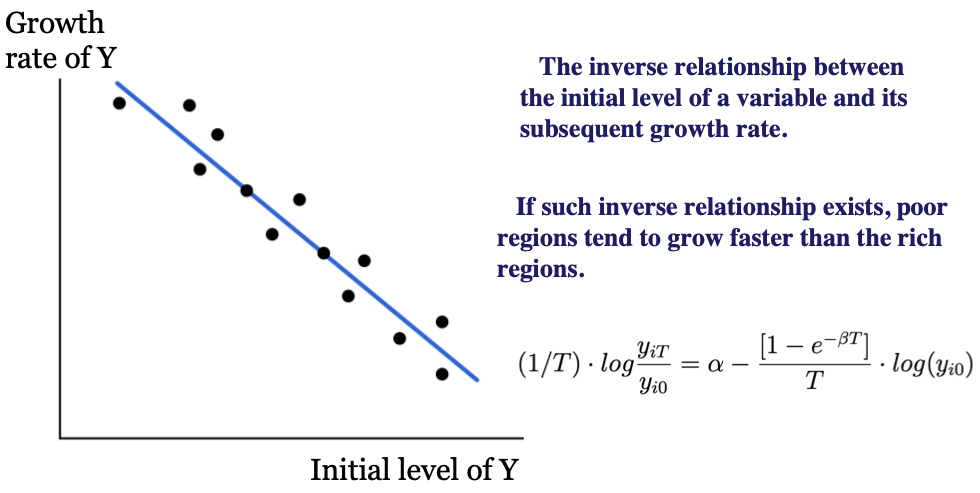
Spatial dependence
Regions interact and their performance is interdependent across space
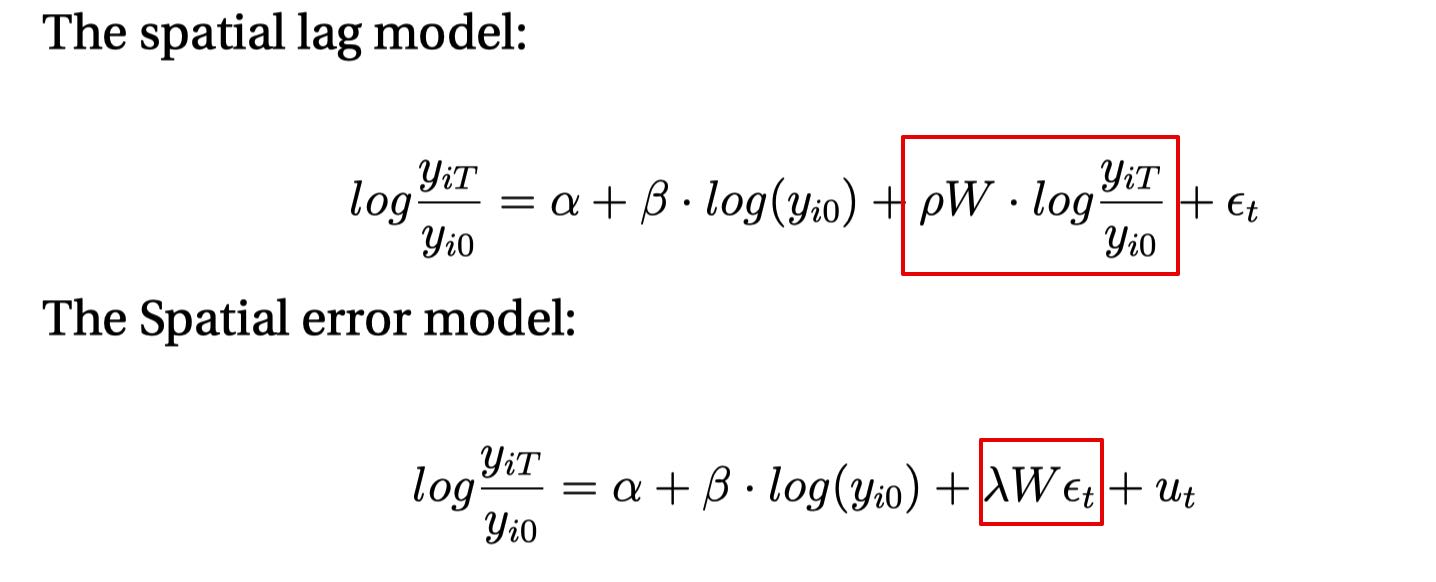
Spatial heterogeneity
Spatial interactions and performance varies across space
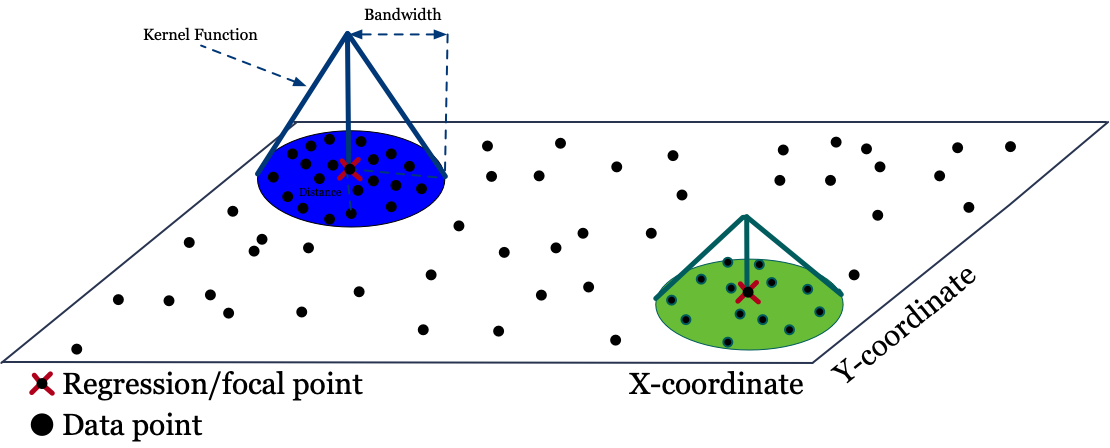
(3) Main results
Convergence and the role of spatial dependence
Convergence and the role of spatial heterogeneity
Spatial dependence in GNI
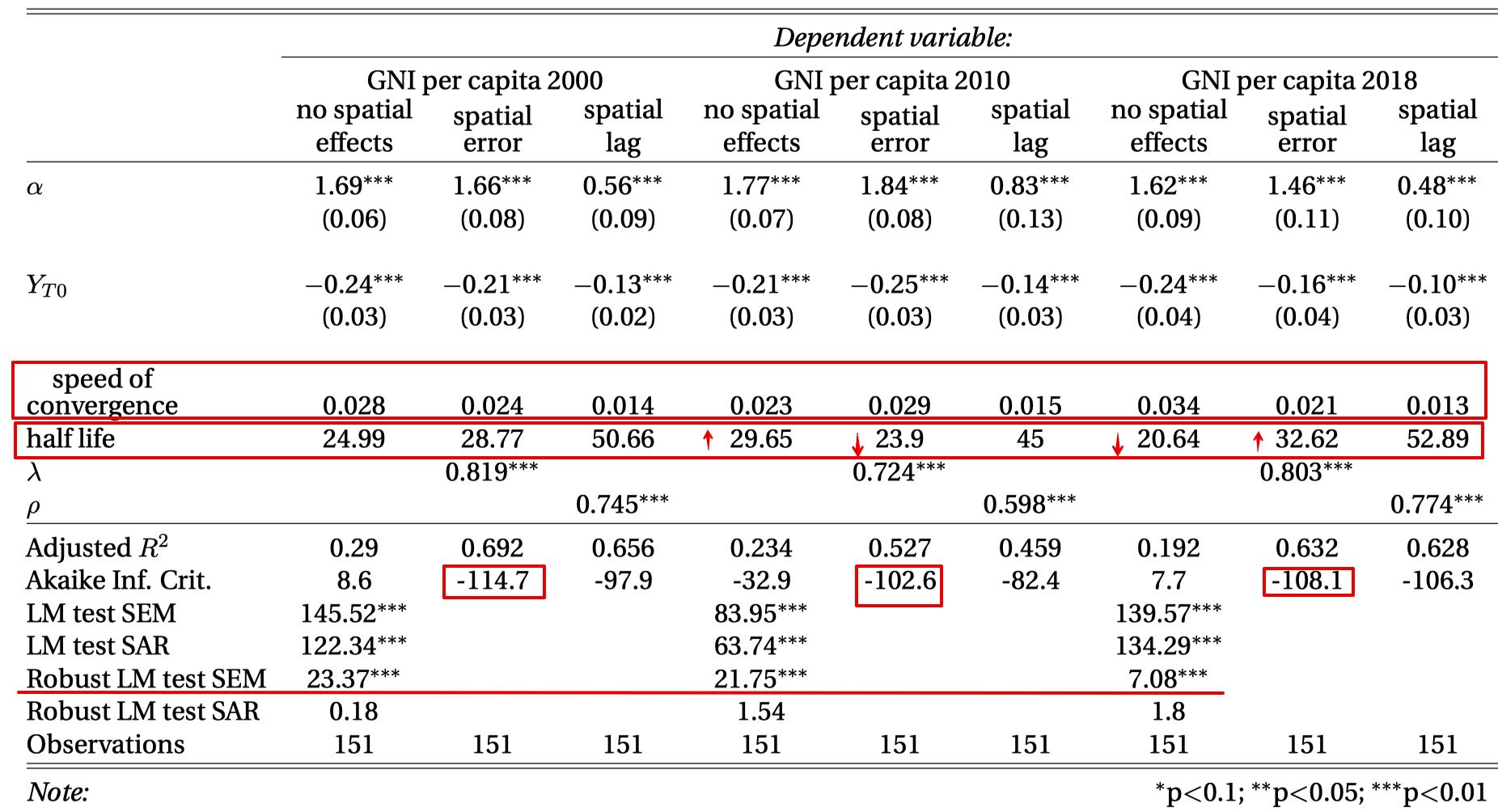
Spatial dependence in HDI
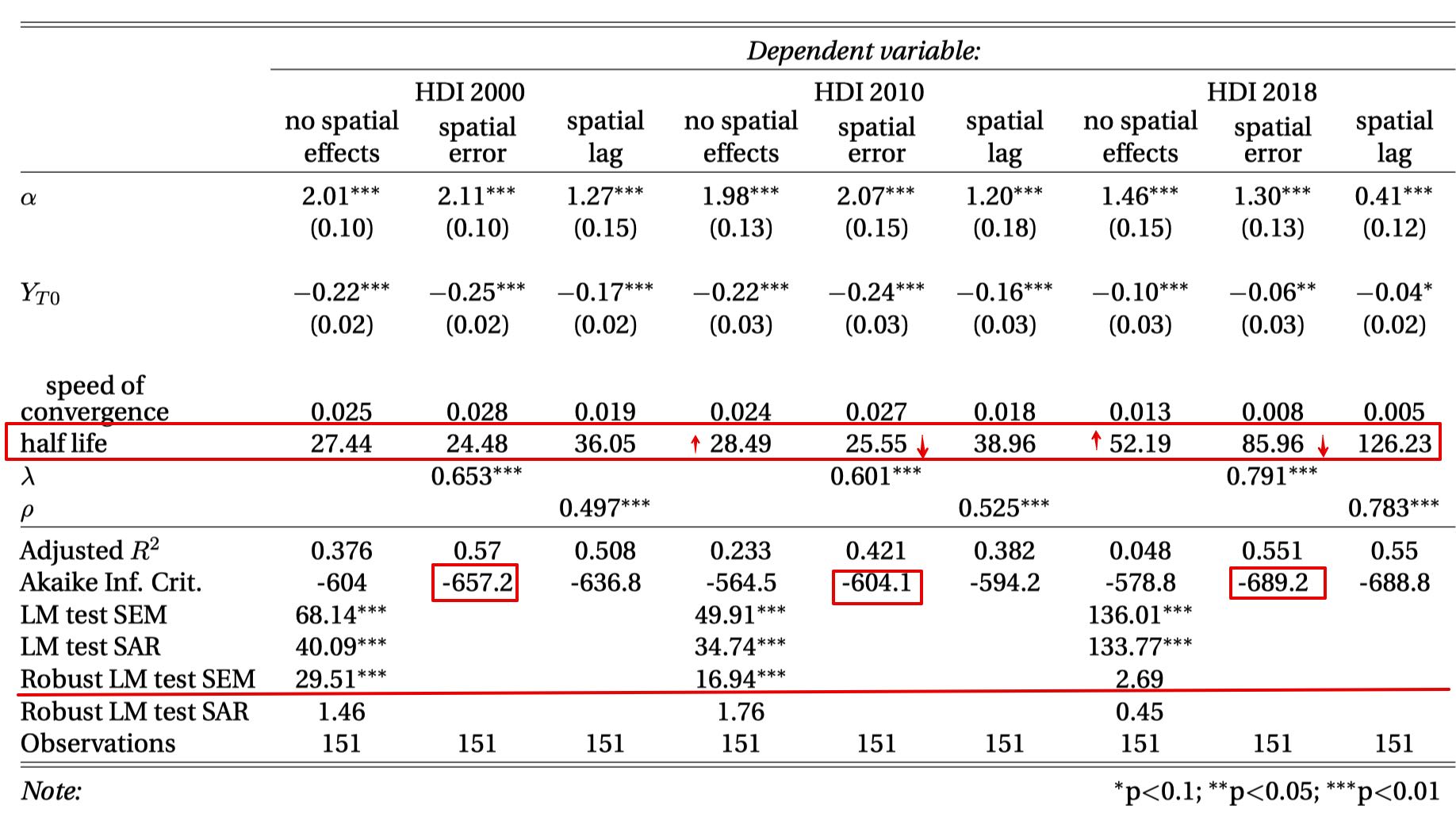
Spatial heterogeneity in GNI
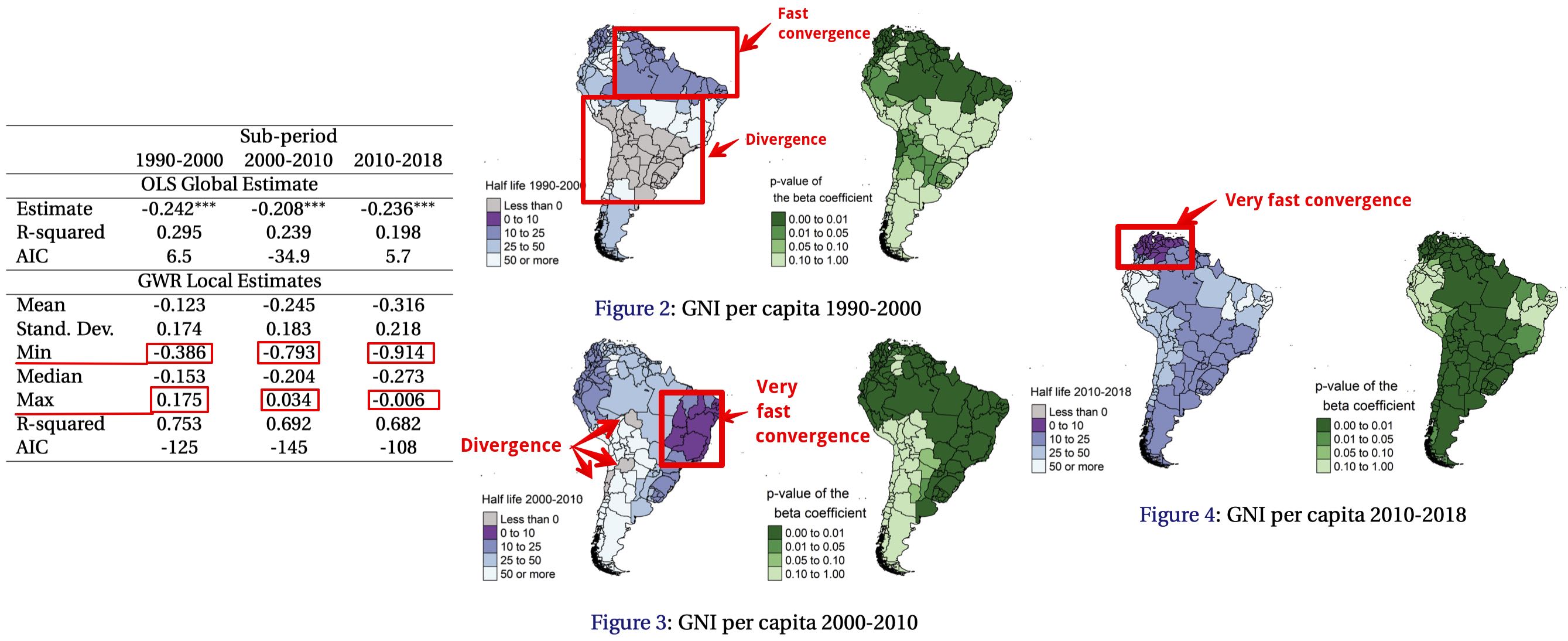
Spatial heterogeneity in HDI
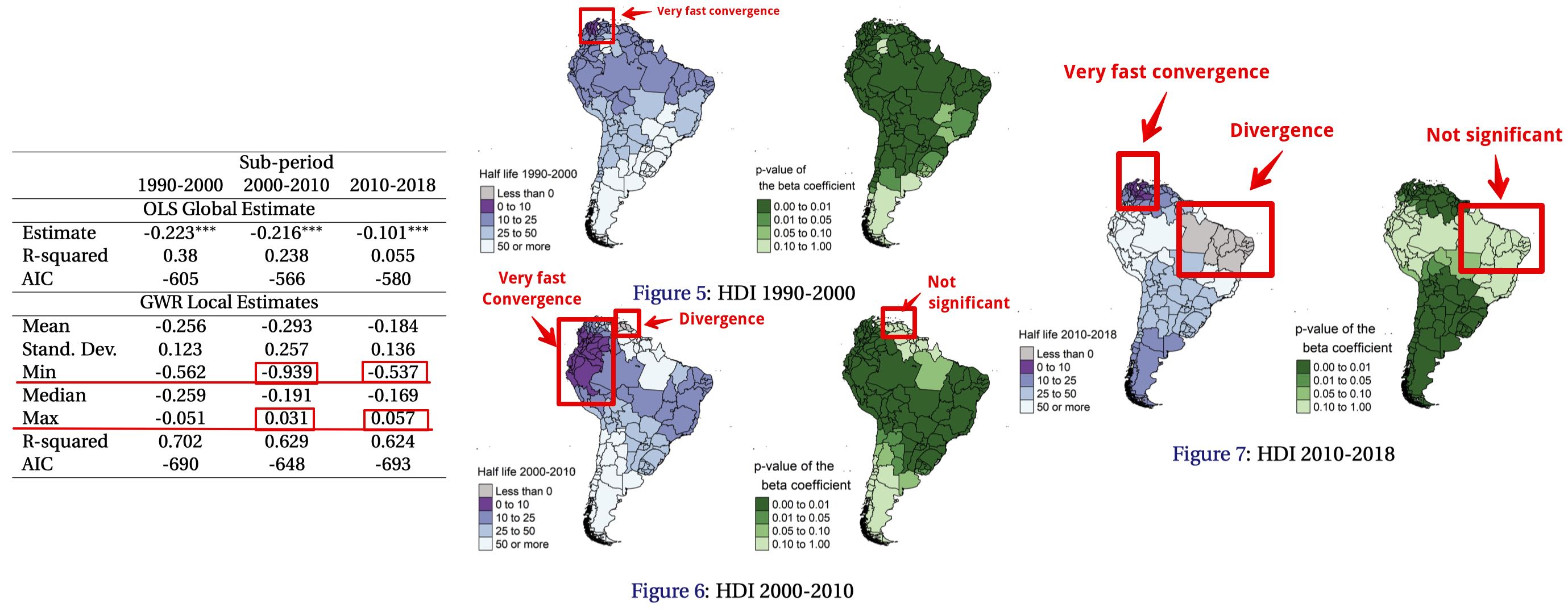
Concluding Remarks
- A standard convergence model indicates that, on average, low-development regions are catching up with high-development regions
- For GNI, this process in not sufficient to reduce regional inequality
Concluding Remarks
- A standard convergence model indicates that, on average, low-development regions are catching up with high-development regions
- For GNI, this process in not sufficient to reduce regional inequality
- Spatial dependence accelerates the speed of regional convergence in some decades, but decelerates it in others.
Concluding Remarks
- A standard convergence model indicates that, on average, low-development regions are catching up with high-development regions
- For GNI, this process in not sufficient to reduce regional inequality
- Spatial dependence accelerates the speed of regional convergence in some decades, but decelerates it in others.
- Beyond the average, the speed of convergence is highly heterogeneous across space
Concluding Remarks
- A standard convergence model indicates that, on average, low-development regions are catching up with high-development regions
- For GNI, this process in not sufficient to reduce regional inequality
- Spatial dependence accelerates the speed of regional convergence in some decades, but decelerates it in others.
- Beyond the average, the speed of convergence is highly heterogeneous across space
Implications
Concluding Remarks
- A standard convergence model indicates that, on average, low-development regions are catching up with high-development regions
- For GNI, this process in not sufficient to reduce regional inequality
- Spatial dependence accelerates the speed of regional convergence in some decades, but decelerates it in others.
- Beyond the average, the speed of convergence is highly heterogeneous across space
Implications
- Spatial dependence and heterogeneity are important for understanding the dynamics of regional inequality
- Single summary indicators that fail to account the role of space could be highly misleading
Concluding Remarks
- A standard convergence model indicates that, on average, low-development regions are catching up with high-development regions
- For GNI, this process in not sufficient to reduce regional inequality
- Spatial dependence accelerates the speed of regional convergence in some decades, but decelerates it in others.
- Beyond the average, the speed of convergence is highly heterogeneous across space
Implications
- Spatial dependence and heterogeneity are important for understanding the dynamics of regional inequality
- Single summary indicators that fail to account the role of space could be highly misleading
- Across subnational regions of South America, economic disparities are more prevalent that social disparities
Concluding Remarks
- A standard convergence model indicates that, on average, low-development regions are catching up with high-development regions
- For GNI, this process in not sufficient to reduce regional inequality
- Spatial dependence accelerates the speed of regional convergence in some decades, but decelerates it in others.
- Beyond the average, the speed of convergence is highly heterogeneous across space
Implications
- Spatial dependence and heterogeneity are important for understanding the dynamics of regional inequality
- Single summary indicators that fail to account the role of space could be highly misleading
- Across subnational regions of South America, economic disparities are more prevalent that social disparities
Further research
Concluding Remarks
- A standard convergence model indicates that, on average, low-development regions are catching up with high-development regions
- For GNI, this process in not sufficient to reduce regional inequality
- Spatial dependence accelerates the speed of regional convergence in some decades, but decelerates it in others.
- Beyond the average, the speed of convergence is highly heterogeneous across space
Implications
- Spatial dependence and heterogeneity are important for understanding the dynamics of regional inequality
- Single summary indicators that fail to account the role of space could be highly misleading
- Across subnational regions of South America, economic disparities are more prevalent that social disparities
Further research
- Use other spatial dependence specifications in a panel-data setting.
- Use multi-scale and mixed geographically weighted regressions.
Thank you very much for your attention
https://carlos-mendez.rbind.io
Slides and working paper available at: https://quarcs-lab.org

Quantitative Regional and Computational Science lab
This research project was supported by JSPS KAKENHI Grant Number 19K13669